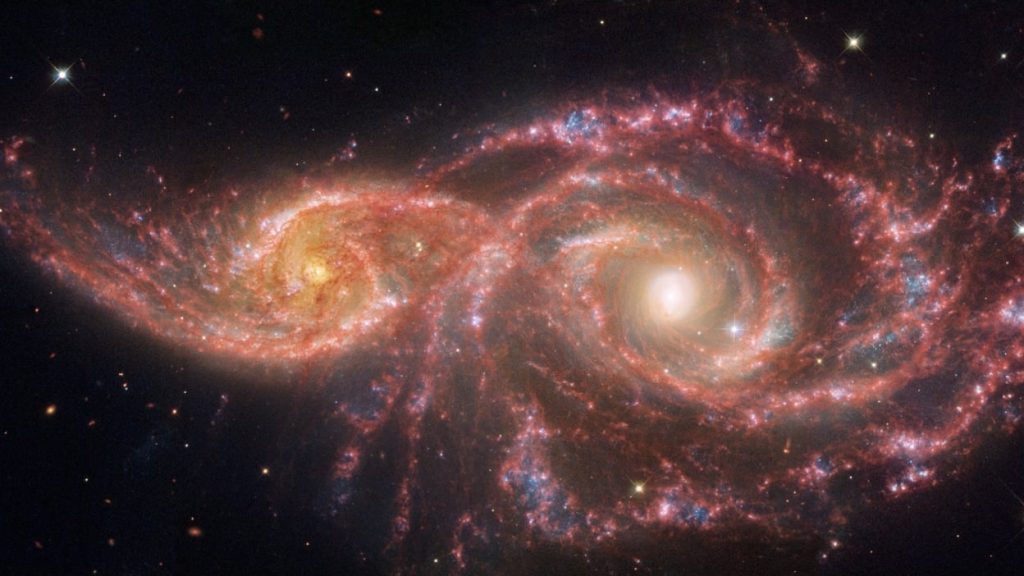
Webb and Hubble telescopes provide a preview to galactic cannibalism (Image Credit: Mashable)
Two spiral galaxies are on the precipice of a messy scuffle — a type of merger known as “galactic cannibalism,” with the larger galaxy stripping stars off the smaller one.
The galaxies, IC 2163 on the left and NGC 2207, are about 114 light-years away from Earth, located in the Eridanus and Canis Major constellations, respectively. NASA and its space agency counterparts have combined data from the James Webb Space Telescope and Hubble Space Telescope to learn more about such cosmic collisions.
The result: The snapshot that appears at the top of this story, the highest-resolution image yet of the galactic pair, revealing new insights into galaxy evolution and star formation.
“Both galaxies have high star formation rates, like innumerable individual hearts fluttering all across their arms,” according to the Space Telescope Science Institute in Baltimore, which runs both telescopes.

Credit: NASA / ESA / CSA / STScI
So far the two galaxies have only brushed against each other, with IC 2163, the smaller of the two, shifting slightly behind the other millions of years ago. You heard that right: This stuff moves slower than a horror film victim, screaming instead of fleeing from impending doom. Galactic collisions, for all their violence, occur over several hundred million years.
As many as 25 percent of galaxies are merging with others right now, and likely even more are affecting neighboring galaxies with their gravity. These interactions and exchanges of material often result in intense bursts of star formation, strongly implying the connection between galaxy mergers and the births of stars, according to the Harvard-Smithsonian Center for Astrophysics.
Combining data from Webb and Hubble has benefits for scientists because the observatories detect light at different wavelengths. To get the full picture of a cosmic object, it helps to have the full range of its electromagnetic spectrum, NASA says. Hubble senses visible light, while Webb picks up invisible light at infrared wavelengths. In short, a lot of dust and gas in space obscures the view to extremely distant and inherently dim light sources, but infrared waves can penetrate through the clouds.

Credit: NASA / ESA / CSA / STScI
Evidence of the previous scrap between the galaxies appears in the shock fronts, where material from the galaxies has crashed into each other, represented in the image at the top of this story in bright red lines and distorted arms.
“Even more tendrils look like they’re hanging between the galaxies’ cores,” according to the institute. “Another extension ‘drifts’ off the top of the larger galaxy, forming a thin, semi-transparent arm that practically runs off screen.”
And it seems the confrontation has already supplied the galaxies with star formation fuel. The areas of bright blue, captured by Hubble in ultraviolet light, and pink and white, mainly caught in mid-infrared by Webb, are star-forming regions.
Some super star clusters peek out in the highest spiral arm that wraps above the larger galaxy on the right. Other bright spots are mini starbursts — locations where new baby stars are churned out rapidly. All around the core of the smaller galaxy on the left is evidence of new stars burning brightly.
This pair of galaxies makes roughly two dozen new stars, each about the size of the sun, every year. That’s about eight times more than the Milky Way‘s rate. The duo has also hosted about seven supernovas, cataclysmic star explosions, over the past few decades. That might not sound like many, but that’s high compared to the average two per century in our home galaxy.
Over eons, the galaxies may continue having these sorts of dalliances, before ultimately merging. It’s hard to know how exactly it will unfold, but scientists think their cores could eventually converge into one. The process will wind down after the interacting regions run out of fuel for making new stars.
Topics
NASA





